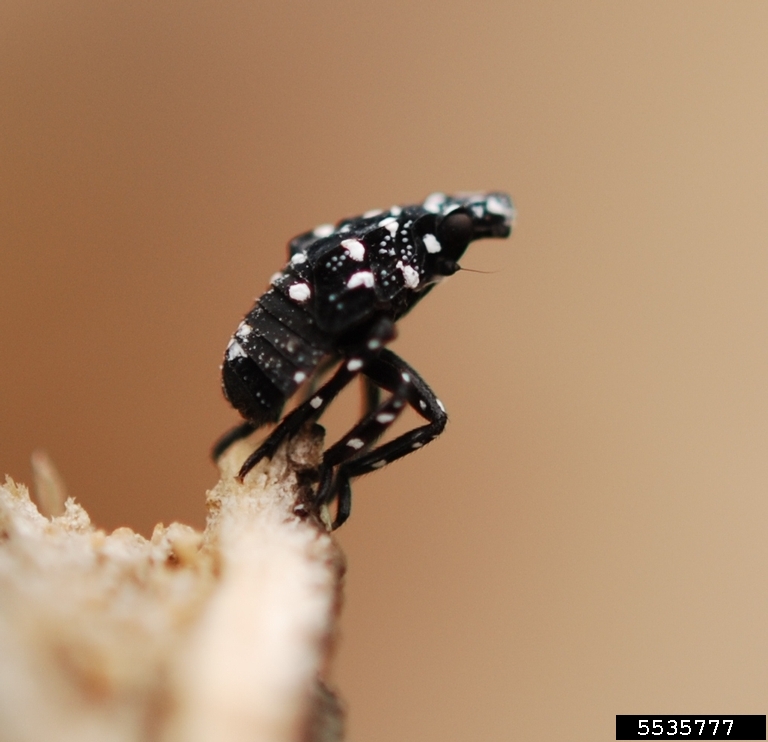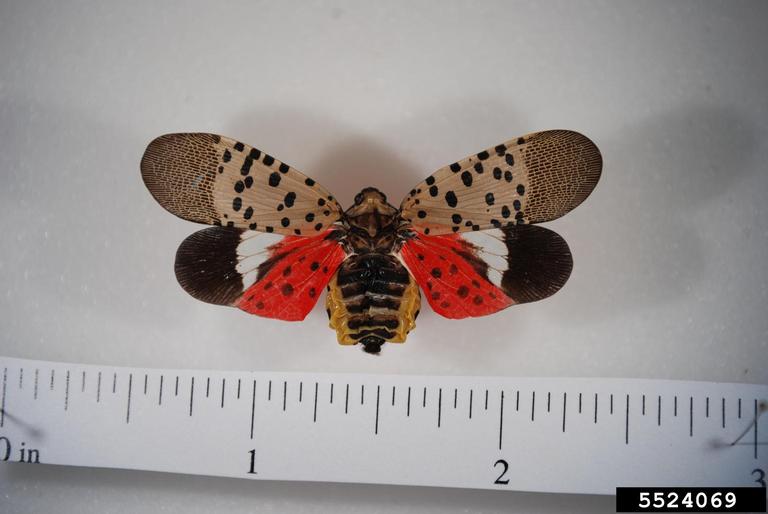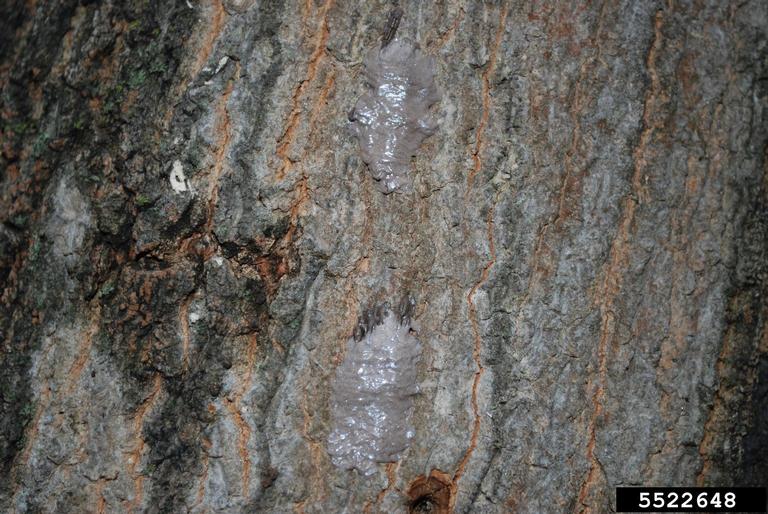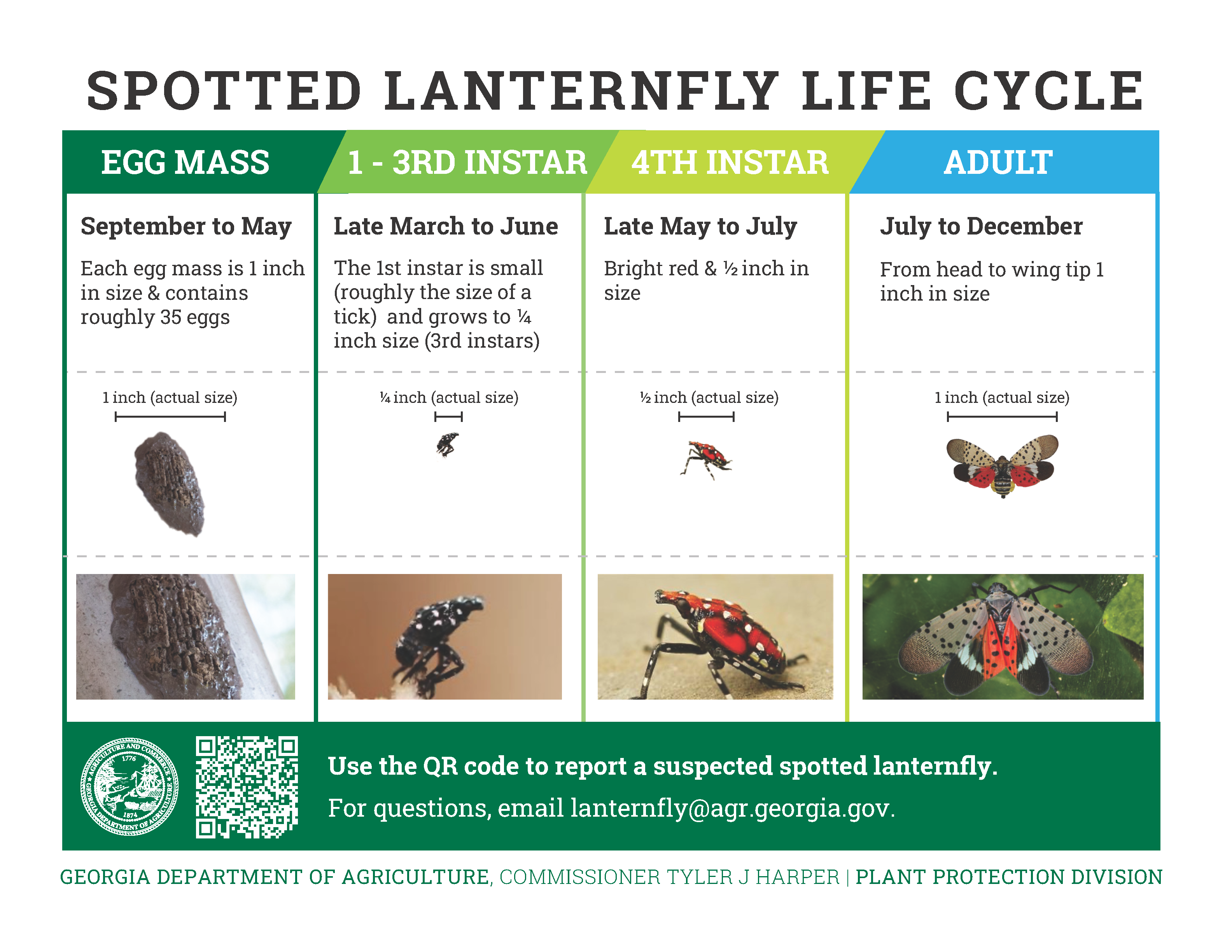Report suspected Spotted Lanternfly

The spotted lanternfly (Lycorma delicatula or SLF) is an invasive planthopper that poses a serious threat to a variety of plants, including grapes, hops, stone fruits, and hardwood trees. While feeding, the SLF excretes a sticky, sugary fluid that can lead to the growth of sooty mold, further damaging the plants. Its primary host is the tree of heaven (Ailanthus altissima), and currently, infestations have been reported in over 17 states.
First detected in the United States in Berks County, Pennsylvania, in 2014, the SLF has since spread to Connecticut, Delaware, Maryland, Ohio, New Jersey, New York, Virginia, Massachusetts, Indiana, Illinois, Kentucky, Tennessee, North Carolina, and West Virginia. Notably, the first live population in Georgia was found in Fulton County in October 2024, marking the only known presence of this pest in the state.
We urge all Georgians to remain vigilant. While spotted lanternflies do not directly threaten human health, they can severely impact our number one industry—agriculture. The Georgia Department of Agriculture encourages Georgians to take action to help slow the spread of this invasive pest. Those traveling to non-infested areas should remember to check RVs, trailers, cars, clothes, camping equipment, etc. Use the Cornell University interactive map to know which areas are infested with SLF.
If you spot a SLF, please follow these steps:
- Take a clear picture
- Kill it.
- Report it using our online reporting tool.
The spotted lanternfly can harm our fruit and forest industries. Early detection is a critical step to reducing economic and ecological losses. Georgia residents should check outdoor items before traveling to new areas. Here's what to look for.
- Appearance
- Nymphs (juvenile spotted lanternflies) are black with white spots and turn red as they develop.


- Adults, roughly 1-inch long and 1/2-inch wide, have a yellow, black-barred abdomen. With large, visually striking wings, adult spotted lanternflies can be easier to spot than other pests. They have brown forewings with black spots at the front and a speckled band at the rear. Their hind wings are scarlet with black spots at the front and white and black bars at the rear.


- Newly laid egg masses (holding 30-50 eggs) resemble wet, gray putty before turning dull and brown, mirroring a smear of cracked mud. The 1-inch long egg masses can be seen in fall, winter, and spring on a variety of smooth surfaces, such as trees, bricks, stones, fences, grills, equipment, and vehicles.

- Oozing sap
- When spotted lanternflies feed on plants, they leave behind a sticky, oozing residue called honeydew. This substance attracts other insects, causes mold growth, and further hurts plants.
- Fermented odor
- As honeydew ferments, it can develop an intense, rotten smell.
- Tree-of-heaven
- One of the best places to look for these pests is on a tree-of-heaven, a favorite plant for spotted lanternflies. The tree has a cantaloupe-like texture, with bark that appears light brown to gray. The leaves are large, 1 to 4 feet in length. These leaves are made up of many smaller leaflets on both sides of a central stem.
- Additional information is available through UGA Extension or here.
- Habits
- Spotted lanternflies (both nymphs and adults) frequently gather in large numbers when feeding. They're easiest to spot at dusk or at night as they migrate up and down the trunk of a plant. During the day, they tend to cluster near the base or canopy of a plant, making them more difficult to see.
Not sure if you've found a spotted lanternfly? Check out our spotted lanternfly lookalikes guide.

You can stop the spotted lanternfly from overtaking plants:
- Regular Checks: Inspect your trees and plants for signs of this pest, particularly at dusk and at night when the insects tend to gather in large groups on trunks and stems.
- Close Car Windows: Spotted lanternflies and their nymphs can enter vehicles unsuspectedly. When parked, make sure to keep windows closed. If possible, try to park 15 feet away from trees in a quarantine zone.
- Check Your Vehicle: Before leaving a parking lot or work site, inspect vehicles for eggs or insects. Check doors, sides, bumpers, wheel wells, grills, and roofs. If found, destroy any eggs or insects you find.
- Winter Prep: When preparing for winter, check your outdoor items for egg masses, including items you may bring indoors.
- Destroy Eggs: Look for egg masses in your trees (in particular, tree-of-heaven), bricks, stones, and other smooth surfaces. If you find eggs, smash them and scrape them into a plastic zippered bag filled with hand sanitizer or rubbing alcohol to kill them. Then, zip the bag shut and dispose of it in the trash.
- Travel Checks: If you're traveling to or through an infested area, thoroughly check your vehicle and clothes to avoid moving the pest to your land and other locations.
- Inspect Items Being Moved: If your business involves moving items, check shipping containers, propane tanks, pallets, and other items being stored outdoors before they're moved offsite. Inspect incoming goods for egg masses and insects.
Please contact a licensed pesticide professional for assistance with applications.
Contact your local UGA Cooperative Extension office for advice and options to control spotted lanternfly.
If you think you have seen Spotted Lanternfly, please take a photo (and try to include a size reference such as a quarter or pen) and upload it with our reporting tool. When submitting a report please include the location of the sighting, the date, and your contact information. If the insect got away, please take a picture of the location where you saw it.


